BSc (Hons) Business Management: Types of Companies Report (BMP3002)
VerifiedAdded on 2022/11/28
|10
|2872
|382
Report
AI Summary
This report, submitted for the Business in Practice module (BMP3002), examines the different types of businesses, including micro, small, medium, and large enterprises, detailing their characteristics and providing UK-based examples. It then explores various business structures, such as sole traders, partnerships, limited liability businesses, public limited liability businesses, and cooperatives, outlining their respective features. The report further analyzes organizational structures, specifically functional and divisional structures, and their impact on business productivity. Finally, it evaluates the influence of external factors on business performance using a PESTLE analysis, with a focus on ASDA, considering political, economic, social, technological, legal, and environmental factors and how they affect the company. The report aims to provide a comprehensive understanding of business operations, structures, and external influences in the UK context.
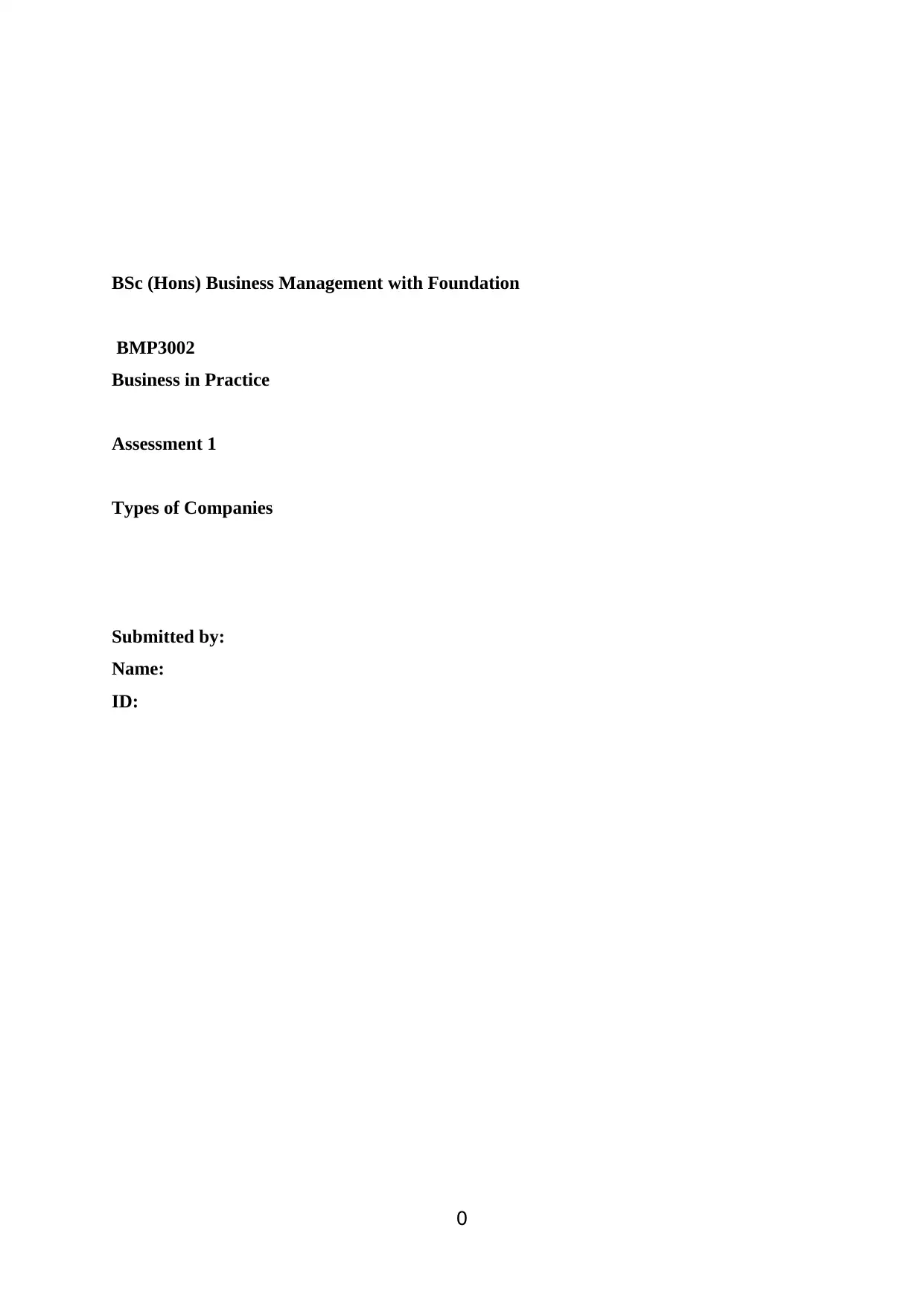
BSc (Hons) Business Management with Foundation
BMP3002
Business in Practice
Assessment 1
Types of Companies
Submitted by:
Name:
ID:
0
BMP3002
Business in Practice
Assessment 1
Types of Companies
Submitted by:
Name:
ID:
0
Paraphrase This Document
Need a fresh take? Get an instant paraphrase of this document with our AI Paraphraser
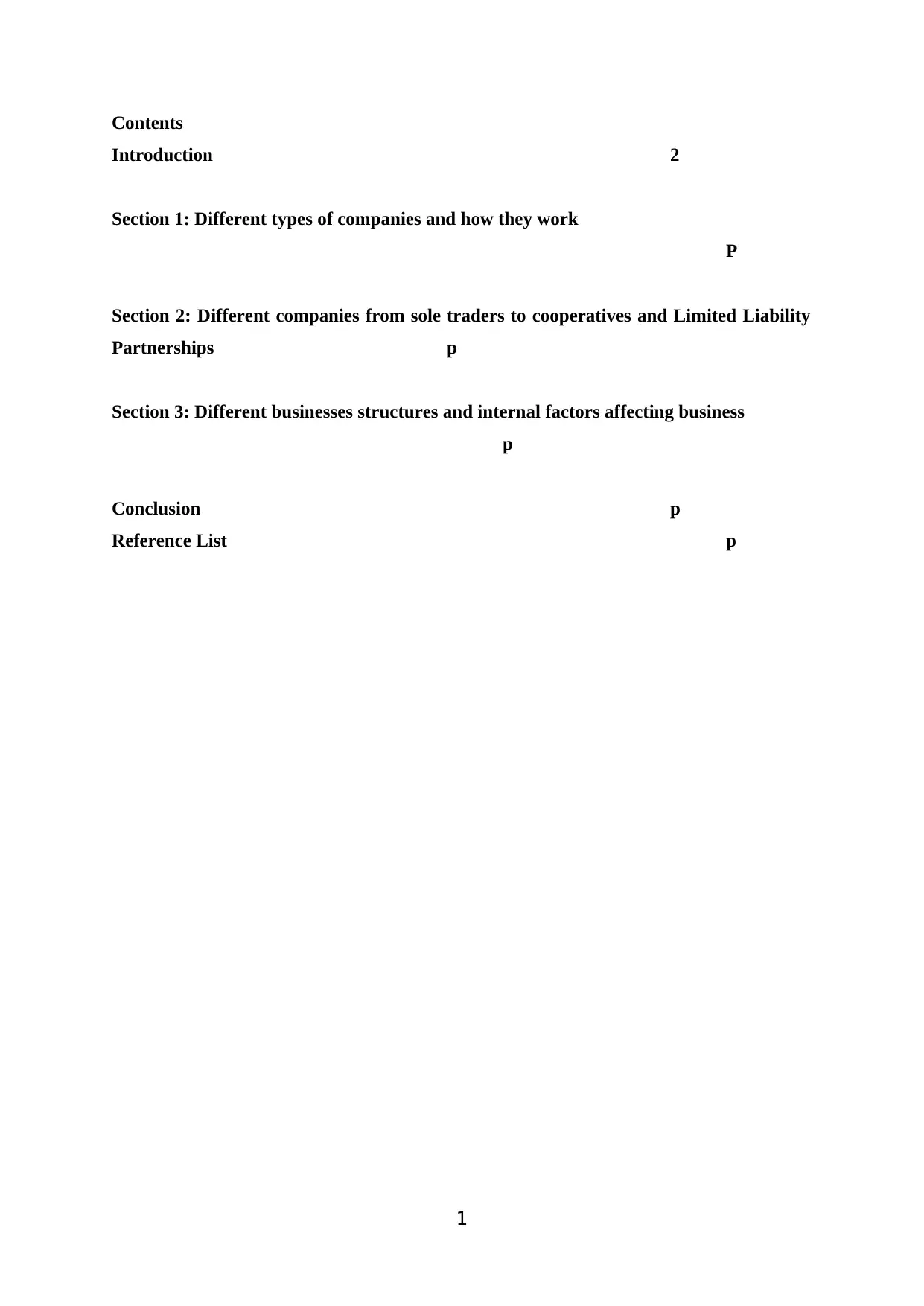
Contents
Introduction 2
Section 1: Different types of companies and how they work
P
Section 2: Different companies from sole traders to cooperatives and Limited Liability
Partnerships p
Section 3: Different businesses structures and internal factors affecting business
p
Conclusion p
Reference List p
1
Introduction 2
Section 1: Different types of companies and how they work
P
Section 2: Different companies from sole traders to cooperatives and Limited Liability
Partnerships p
Section 3: Different businesses structures and internal factors affecting business
p
Conclusion p
Reference List p
1
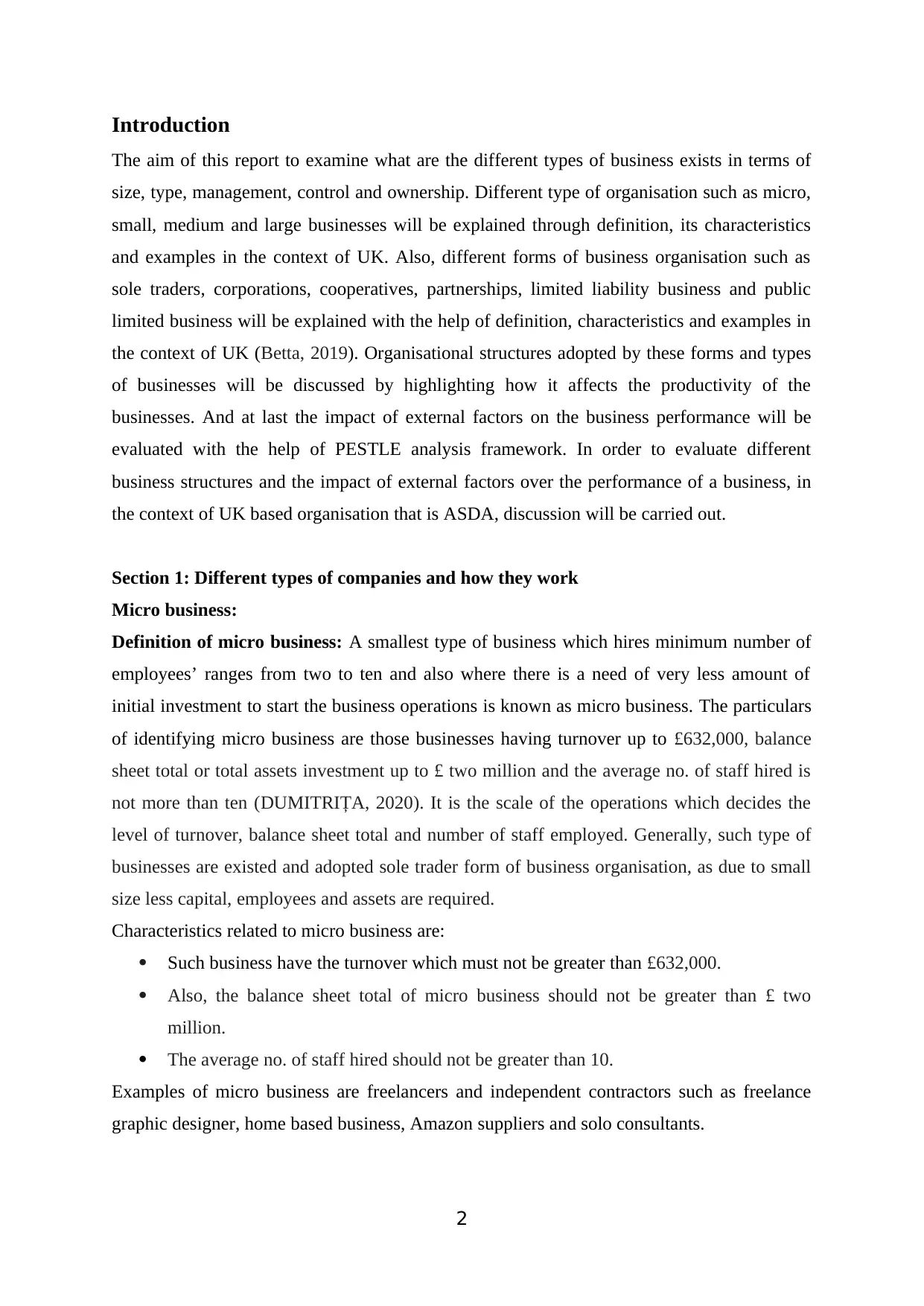
Introduction
The aim of this report to examine what are the different types of business exists in terms of
size, type, management, control and ownership. Different type of organisation such as micro,
small, medium and large businesses will be explained through definition, its characteristics
and examples in the context of UK. Also, different forms of business organisation such as
sole traders, corporations, cooperatives, partnerships, limited liability business and public
limited business will be explained with the help of definition, characteristics and examples in
the context of UK (Betta, 2019). Organisational structures adopted by these forms and types
of businesses will be discussed by highlighting how it affects the productivity of the
businesses. And at last the impact of external factors on the business performance will be
evaluated with the help of PESTLE analysis framework. In order to evaluate different
business structures and the impact of external factors over the performance of a business, in
the context of UK based organisation that is ASDA, discussion will be carried out.
Section 1: Different types of companies and how they work
Micro business:
Definition of micro business: A smallest type of business which hires minimum number of
employees’ ranges from two to ten and also where there is a need of very less amount of
initial investment to start the business operations is known as micro business. The particulars
of identifying micro business are those businesses having turnover up to £632,000, balance
sheet total or total assets investment up to £ two million and the average no. of staff hired is
not more than ten (DUMITRIȚA, 2020). It is the scale of the operations which decides the
level of turnover, balance sheet total and number of staff employed. Generally, such type of
businesses are existed and adopted sole trader form of business organisation, as due to small
size less capital, employees and assets are required.
Characteristics related to micro business are:
Such business have the turnover which must not be greater than £632,000.
Also, the balance sheet total of micro business should not be greater than £ two
million.
The average no. of staff hired should not be greater than 10.
Examples of micro business are freelancers and independent contractors such as freelance
graphic designer, home based business, Amazon suppliers and solo consultants.
2
The aim of this report to examine what are the different types of business exists in terms of
size, type, management, control and ownership. Different type of organisation such as micro,
small, medium and large businesses will be explained through definition, its characteristics
and examples in the context of UK. Also, different forms of business organisation such as
sole traders, corporations, cooperatives, partnerships, limited liability business and public
limited business will be explained with the help of definition, characteristics and examples in
the context of UK (Betta, 2019). Organisational structures adopted by these forms and types
of businesses will be discussed by highlighting how it affects the productivity of the
businesses. And at last the impact of external factors on the business performance will be
evaluated with the help of PESTLE analysis framework. In order to evaluate different
business structures and the impact of external factors over the performance of a business, in
the context of UK based organisation that is ASDA, discussion will be carried out.
Section 1: Different types of companies and how they work
Micro business:
Definition of micro business: A smallest type of business which hires minimum number of
employees’ ranges from two to ten and also where there is a need of very less amount of
initial investment to start the business operations is known as micro business. The particulars
of identifying micro business are those businesses having turnover up to £632,000, balance
sheet total or total assets investment up to £ two million and the average no. of staff hired is
not more than ten (DUMITRIȚA, 2020). It is the scale of the operations which decides the
level of turnover, balance sheet total and number of staff employed. Generally, such type of
businesses are existed and adopted sole trader form of business organisation, as due to small
size less capital, employees and assets are required.
Characteristics related to micro business are:
Such business have the turnover which must not be greater than £632,000.
Also, the balance sheet total of micro business should not be greater than £ two
million.
The average no. of staff hired should not be greater than 10.
Examples of micro business are freelancers and independent contractors such as freelance
graphic designer, home based business, Amazon suppliers and solo consultants.
2
⊘ This is a preview!⊘
Do you want full access?
Subscribe today to unlock all pages.

Trusted by 1+ million students worldwide
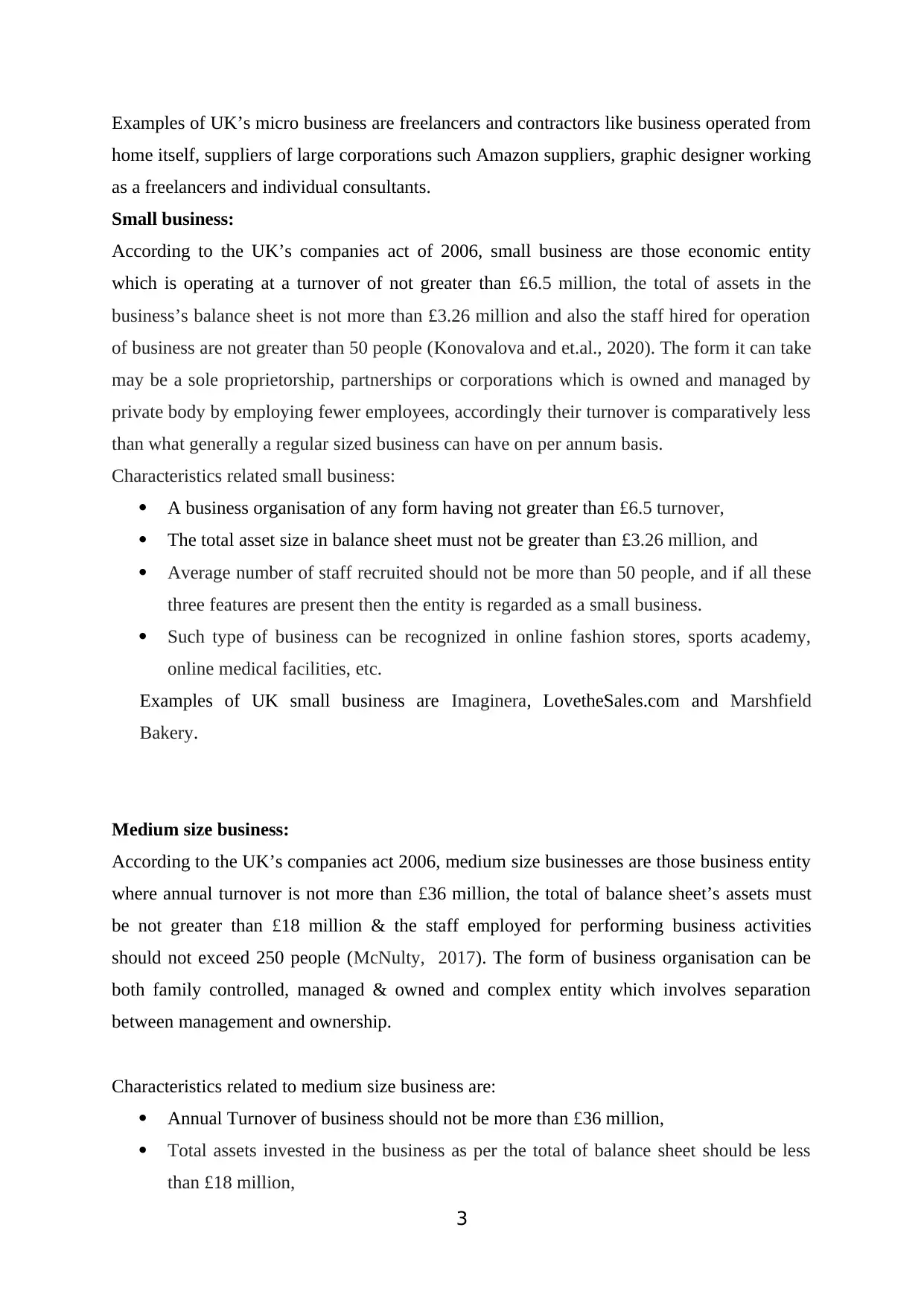
Examples of UK’s micro business are freelancers and contractors like business operated from
home itself, suppliers of large corporations such Amazon suppliers, graphic designer working
as a freelancers and individual consultants.
Small business:
According to the UK’s companies act of 2006, small business are those economic entity
which is operating at a turnover of not greater than £6.5 million, the total of assets in the
business’s balance sheet is not more than £3.26 million and also the staff hired for operation
of business are not greater than 50 people (Konovalova and et.al., 2020). The form it can take
may be a sole proprietorship, partnerships or corporations which is owned and managed by
private body by employing fewer employees, accordingly their turnover is comparatively less
than what generally a regular sized business can have on per annum basis.
Characteristics related small business:
A business organisation of any form having not greater than £6.5 turnover,
The total asset size in balance sheet must not be greater than £3.26 million, and
Average number of staff recruited should not be more than 50 people, and if all these
three features are present then the entity is regarded as a small business.
Such type of business can be recognized in online fashion stores, sports academy,
online medical facilities, etc.
Examples of UK small business are Imaginera, LovetheSales.com and Marshfield
Bakery.
Medium size business:
According to the UK’s companies act 2006, medium size businesses are those business entity
where annual turnover is not more than £36 million, the total of balance sheet’s assets must
be not greater than £18 million & the staff employed for performing business activities
should not exceed 250 people (McNulty, 2017). The form of business organisation can be
both family controlled, managed & owned and complex entity which involves separation
between management and ownership.
Characteristics related to medium size business are:
Annual Turnover of business should not be more than £36 million,
Total assets invested in the business as per the total of balance sheet should be less
than £18 million,
3
home itself, suppliers of large corporations such Amazon suppliers, graphic designer working
as a freelancers and individual consultants.
Small business:
According to the UK’s companies act of 2006, small business are those economic entity
which is operating at a turnover of not greater than £6.5 million, the total of assets in the
business’s balance sheet is not more than £3.26 million and also the staff hired for operation
of business are not greater than 50 people (Konovalova and et.al., 2020). The form it can take
may be a sole proprietorship, partnerships or corporations which is owned and managed by
private body by employing fewer employees, accordingly their turnover is comparatively less
than what generally a regular sized business can have on per annum basis.
Characteristics related small business:
A business organisation of any form having not greater than £6.5 turnover,
The total asset size in balance sheet must not be greater than £3.26 million, and
Average number of staff recruited should not be more than 50 people, and if all these
three features are present then the entity is regarded as a small business.
Such type of business can be recognized in online fashion stores, sports academy,
online medical facilities, etc.
Examples of UK small business are Imaginera, LovetheSales.com and Marshfield
Bakery.
Medium size business:
According to the UK’s companies act 2006, medium size businesses are those business entity
where annual turnover is not more than £36 million, the total of balance sheet’s assets must
be not greater than £18 million & the staff employed for performing business activities
should not exceed 250 people (McNulty, 2017). The form of business organisation can be
both family controlled, managed & owned and complex entity which involves separation
between management and ownership.
Characteristics related to medium size business are:
Annual Turnover of business should not be more than £36 million,
Total assets invested in the business as per the total of balance sheet should be less
than £18 million,
3
Paraphrase This Document
Need a fresh take? Get an instant paraphrase of this document with our AI Paraphraser
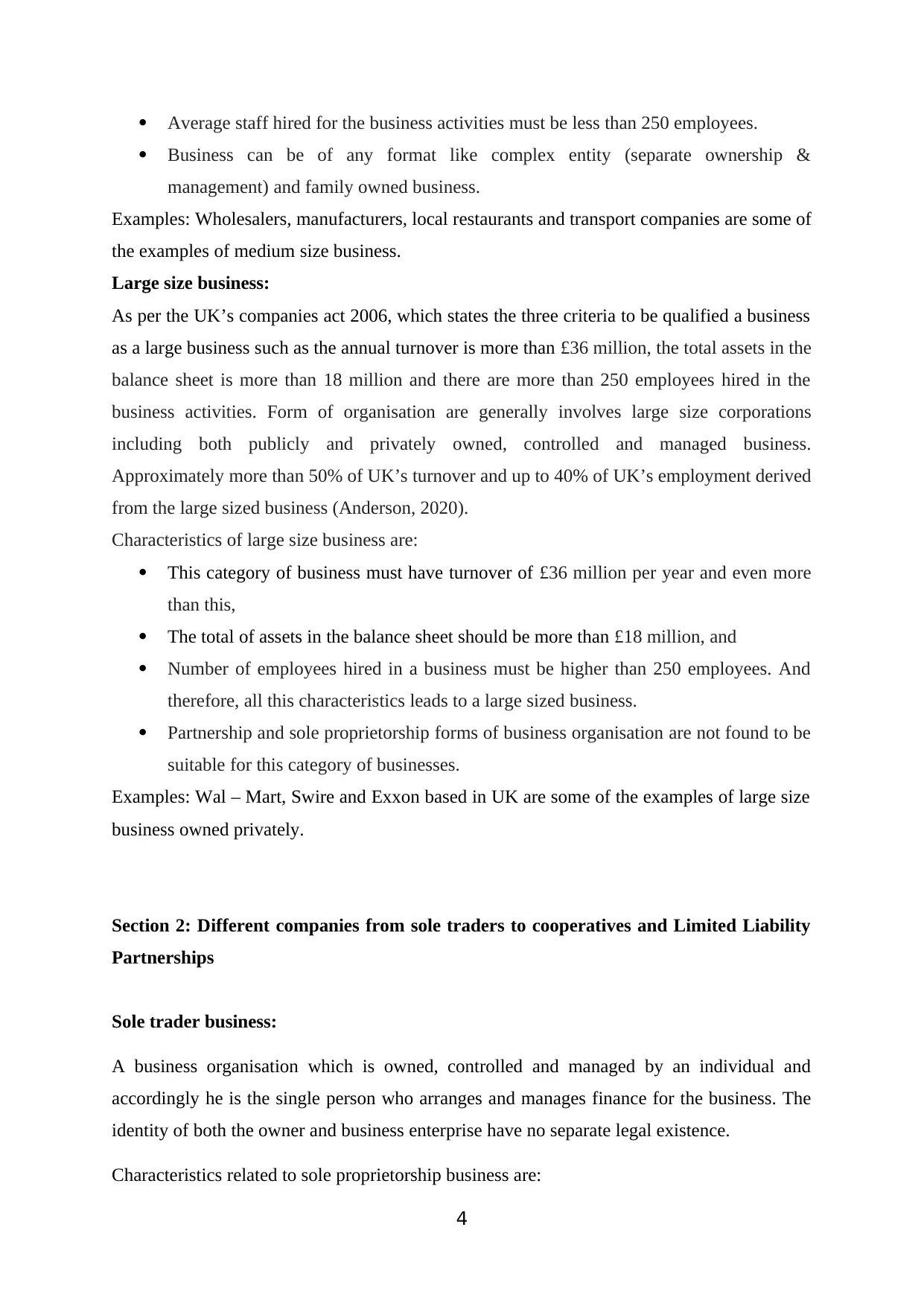
Average staff hired for the business activities must be less than 250 employees.
Business can be of any format like complex entity (separate ownership &
management) and family owned business.
Examples: Wholesalers, manufacturers, local restaurants and transport companies are some of
the examples of medium size business.
Large size business:
As per the UK’s companies act 2006, which states the three criteria to be qualified a business
as a large business such as the annual turnover is more than £36 million, the total assets in the
balance sheet is more than 18 million and there are more than 250 employees hired in the
business activities. Form of organisation are generally involves large size corporations
including both publicly and privately owned, controlled and managed business.
Approximately more than 50% of UK’s turnover and up to 40% of UK’s employment derived
from the large sized business (Anderson, 2020).
Characteristics of large size business are:
This category of business must have turnover of £36 million per year and even more
than this,
The total of assets in the balance sheet should be more than £18 million, and
Number of employees hired in a business must be higher than 250 employees. And
therefore, all this characteristics leads to a large sized business.
Partnership and sole proprietorship forms of business organisation are not found to be
suitable for this category of businesses.
Examples: Wal – Mart, Swire and Exxon based in UK are some of the examples of large size
business owned privately.
Section 2: Different companies from sole traders to cooperatives and Limited Liability
Partnerships
Sole trader business:
A business organisation which is owned, controlled and managed by an individual and
accordingly he is the single person who arranges and manages finance for the business. The
identity of both the owner and business enterprise have no separate legal existence.
Characteristics related to sole proprietorship business are:
4
Business can be of any format like complex entity (separate ownership &
management) and family owned business.
Examples: Wholesalers, manufacturers, local restaurants and transport companies are some of
the examples of medium size business.
Large size business:
As per the UK’s companies act 2006, which states the three criteria to be qualified a business
as a large business such as the annual turnover is more than £36 million, the total assets in the
balance sheet is more than 18 million and there are more than 250 employees hired in the
business activities. Form of organisation are generally involves large size corporations
including both publicly and privately owned, controlled and managed business.
Approximately more than 50% of UK’s turnover and up to 40% of UK’s employment derived
from the large sized business (Anderson, 2020).
Characteristics of large size business are:
This category of business must have turnover of £36 million per year and even more
than this,
The total of assets in the balance sheet should be more than £18 million, and
Number of employees hired in a business must be higher than 250 employees. And
therefore, all this characteristics leads to a large sized business.
Partnership and sole proprietorship forms of business organisation are not found to be
suitable for this category of businesses.
Examples: Wal – Mart, Swire and Exxon based in UK are some of the examples of large size
business owned privately.
Section 2: Different companies from sole traders to cooperatives and Limited Liability
Partnerships
Sole trader business:
A business organisation which is owned, controlled and managed by an individual and
accordingly he is the single person who arranges and manages finance for the business. The
identity of both the owner and business enterprise have no separate legal existence.
Characteristics related to sole proprietorship business are:
4
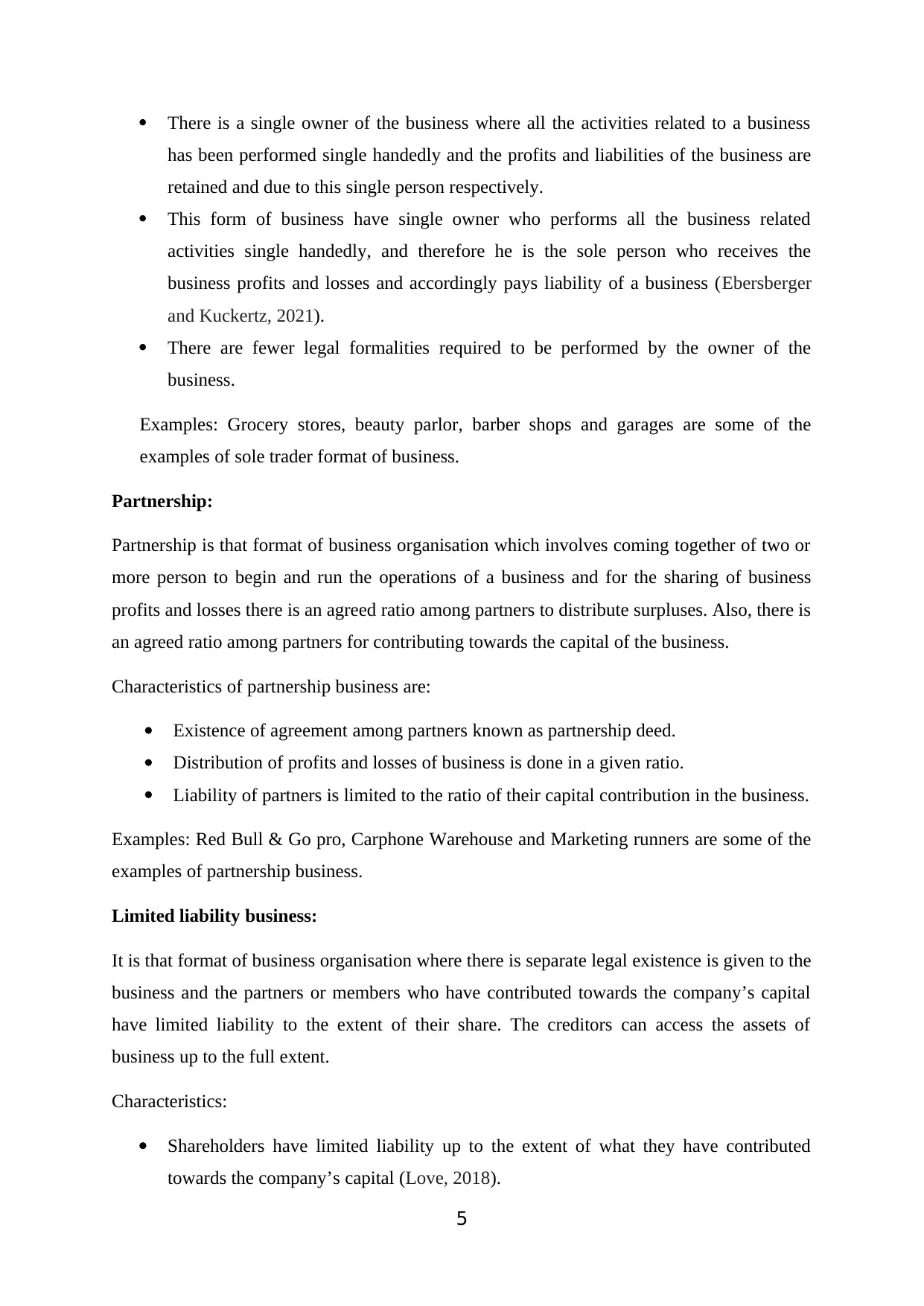
There is a single owner of the business where all the activities related to a business
has been performed single handedly and the profits and liabilities of the business are
retained and due to this single person respectively.
This form of business have single owner who performs all the business related
activities single handedly, and therefore he is the sole person who receives the
business profits and losses and accordingly pays liability of a business (Ebersberger
and Kuckertz, 2021).
There are fewer legal formalities required to be performed by the owner of the
business.
Examples: Grocery stores, beauty parlor, barber shops and garages are some of the
examples of sole trader format of business.
Partnership:
Partnership is that format of business organisation which involves coming together of two or
more person to begin and run the operations of a business and for the sharing of business
profits and losses there is an agreed ratio among partners to distribute surpluses. Also, there is
an agreed ratio among partners for contributing towards the capital of the business.
Characteristics of partnership business are:
Existence of agreement among partners known as partnership deed.
Distribution of profits and losses of business is done in a given ratio.
Liability of partners is limited to the ratio of their capital contribution in the business.
Examples: Red Bull & Go pro, Carphone Warehouse and Marketing runners are some of the
examples of partnership business.
Limited liability business:
It is that format of business organisation where there is separate legal existence is given to the
business and the partners or members who have contributed towards the company’s capital
have limited liability to the extent of their share. The creditors can access the assets of
business up to the full extent.
Characteristics:
Shareholders have limited liability up to the extent of what they have contributed
towards the company’s capital (Love, 2018).
5
has been performed single handedly and the profits and liabilities of the business are
retained and due to this single person respectively.
This form of business have single owner who performs all the business related
activities single handedly, and therefore he is the sole person who receives the
business profits and losses and accordingly pays liability of a business (Ebersberger
and Kuckertz, 2021).
There are fewer legal formalities required to be performed by the owner of the
business.
Examples: Grocery stores, beauty parlor, barber shops and garages are some of the
examples of sole trader format of business.
Partnership:
Partnership is that format of business organisation which involves coming together of two or
more person to begin and run the operations of a business and for the sharing of business
profits and losses there is an agreed ratio among partners to distribute surpluses. Also, there is
an agreed ratio among partners for contributing towards the capital of the business.
Characteristics of partnership business are:
Existence of agreement among partners known as partnership deed.
Distribution of profits and losses of business is done in a given ratio.
Liability of partners is limited to the ratio of their capital contribution in the business.
Examples: Red Bull & Go pro, Carphone Warehouse and Marketing runners are some of the
examples of partnership business.
Limited liability business:
It is that format of business organisation where there is separate legal existence is given to the
business and the partners or members who have contributed towards the company’s capital
have limited liability to the extent of their share. The creditors can access the assets of
business up to the full extent.
Characteristics:
Shareholders have limited liability up to the extent of what they have contributed
towards the company’s capital (Love, 2018).
5
⊘ This is a preview!⊘
Do you want full access?
Subscribe today to unlock all pages.

Trusted by 1+ million students worldwide
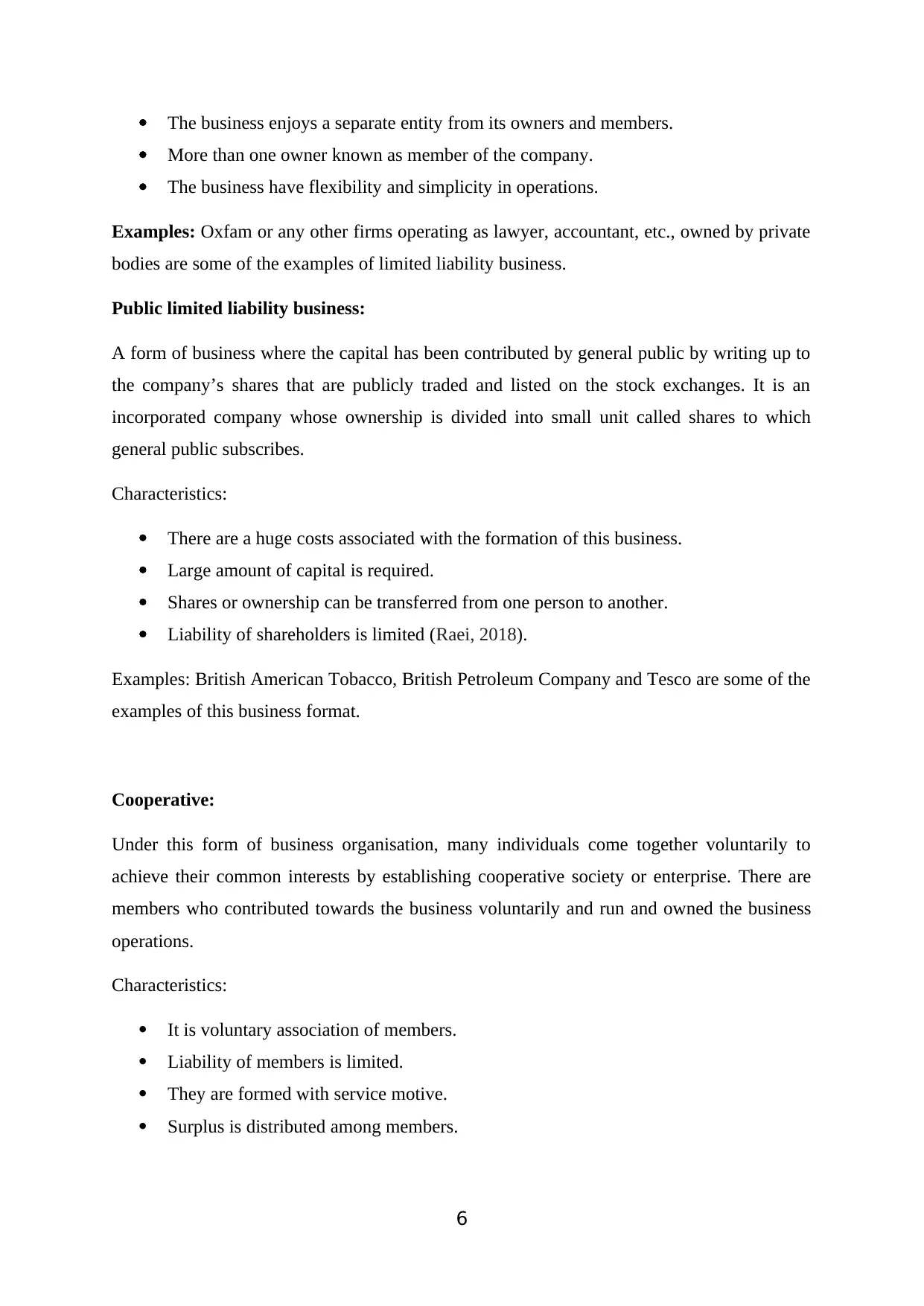
The business enjoys a separate entity from its owners and members.
More than one owner known as member of the company.
The business have flexibility and simplicity in operations.
Examples: Oxfam or any other firms operating as lawyer, accountant, etc., owned by private
bodies are some of the examples of limited liability business.
Public limited liability business:
A form of business where the capital has been contributed by general public by writing up to
the company’s shares that are publicly traded and listed on the stock exchanges. It is an
incorporated company whose ownership is divided into small unit called shares to which
general public subscribes.
Characteristics:
There are a huge costs associated with the formation of this business.
Large amount of capital is required.
Shares or ownership can be transferred from one person to another.
Liability of shareholders is limited (Raei, 2018).
Examples: British American Tobacco, British Petroleum Company and Tesco are some of the
examples of this business format.
Cooperative:
Under this form of business organisation, many individuals come together voluntarily to
achieve their common interests by establishing cooperative society or enterprise. There are
members who contributed towards the business voluntarily and run and owned the business
operations.
Characteristics:
It is voluntary association of members.
Liability of members is limited.
They are formed with service motive.
Surplus is distributed among members.
6
More than one owner known as member of the company.
The business have flexibility and simplicity in operations.
Examples: Oxfam or any other firms operating as lawyer, accountant, etc., owned by private
bodies are some of the examples of limited liability business.
Public limited liability business:
A form of business where the capital has been contributed by general public by writing up to
the company’s shares that are publicly traded and listed on the stock exchanges. It is an
incorporated company whose ownership is divided into small unit called shares to which
general public subscribes.
Characteristics:
There are a huge costs associated with the formation of this business.
Large amount of capital is required.
Shares or ownership can be transferred from one person to another.
Liability of shareholders is limited (Raei, 2018).
Examples: British American Tobacco, British Petroleum Company and Tesco are some of the
examples of this business format.
Cooperative:
Under this form of business organisation, many individuals come together voluntarily to
achieve their common interests by establishing cooperative society or enterprise. There are
members who contributed towards the business voluntarily and run and owned the business
operations.
Characteristics:
It is voluntary association of members.
Liability of members is limited.
They are formed with service motive.
Surplus is distributed among members.
6
Paraphrase This Document
Need a fresh take? Get an instant paraphrase of this document with our AI Paraphraser
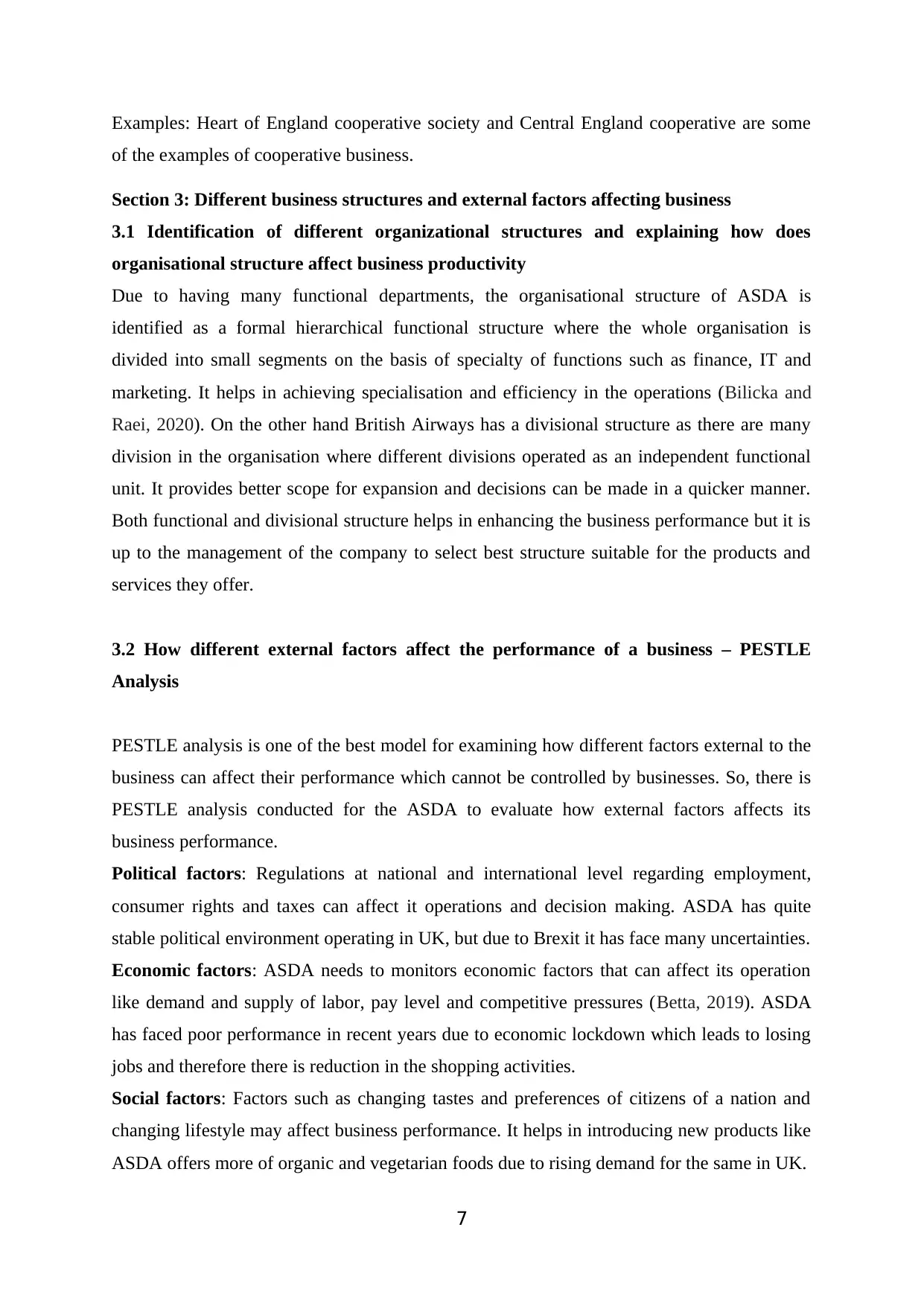
Examples: Heart of England cooperative society and Central England cooperative are some
of the examples of cooperative business.
Section 3: Different business structures and external factors affecting business
3.1 Identification of different organizational structures and explaining how does
organisational structure affect business productivity
Due to having many functional departments, the organisational structure of ASDA is
identified as a formal hierarchical functional structure where the whole organisation is
divided into small segments on the basis of specialty of functions such as finance, IT and
marketing. It helps in achieving specialisation and efficiency in the operations (Bilicka and
Raei, 2020). On the other hand British Airways has a divisional structure as there are many
division in the organisation where different divisions operated as an independent functional
unit. It provides better scope for expansion and decisions can be made in a quicker manner.
Both functional and divisional structure helps in enhancing the business performance but it is
up to the management of the company to select best structure suitable for the products and
services they offer.
3.2 How different external factors affect the performance of a business – PESTLE
Analysis
PESTLE analysis is one of the best model for examining how different factors external to the
business can affect their performance which cannot be controlled by businesses. So, there is
PESTLE analysis conducted for the ASDA to evaluate how external factors affects its
business performance.
Political factors: Regulations at national and international level regarding employment,
consumer rights and taxes can affect it operations and decision making. ASDA has quite
stable political environment operating in UK, but due to Brexit it has face many uncertainties.
Economic factors: ASDA needs to monitors economic factors that can affect its operation
like demand and supply of labor, pay level and competitive pressures (Betta, 2019). ASDA
has faced poor performance in recent years due to economic lockdown which leads to losing
jobs and therefore there is reduction in the shopping activities.
Social factors: Factors such as changing tastes and preferences of citizens of a nation and
changing lifestyle may affect business performance. It helps in introducing new products like
ASDA offers more of organic and vegetarian foods due to rising demand for the same in UK.
7
of the examples of cooperative business.
Section 3: Different business structures and external factors affecting business
3.1 Identification of different organizational structures and explaining how does
organisational structure affect business productivity
Due to having many functional departments, the organisational structure of ASDA is
identified as a formal hierarchical functional structure where the whole organisation is
divided into small segments on the basis of specialty of functions such as finance, IT and
marketing. It helps in achieving specialisation and efficiency in the operations (Bilicka and
Raei, 2020). On the other hand British Airways has a divisional structure as there are many
division in the organisation where different divisions operated as an independent functional
unit. It provides better scope for expansion and decisions can be made in a quicker manner.
Both functional and divisional structure helps in enhancing the business performance but it is
up to the management of the company to select best structure suitable for the products and
services they offer.
3.2 How different external factors affect the performance of a business – PESTLE
Analysis
PESTLE analysis is one of the best model for examining how different factors external to the
business can affect their performance which cannot be controlled by businesses. So, there is
PESTLE analysis conducted for the ASDA to evaluate how external factors affects its
business performance.
Political factors: Regulations at national and international level regarding employment,
consumer rights and taxes can affect it operations and decision making. ASDA has quite
stable political environment operating in UK, but due to Brexit it has face many uncertainties.
Economic factors: ASDA needs to monitors economic factors that can affect its operation
like demand and supply of labor, pay level and competitive pressures (Betta, 2019). ASDA
has faced poor performance in recent years due to economic lockdown which leads to losing
jobs and therefore there is reduction in the shopping activities.
Social factors: Factors such as changing tastes and preferences of citizens of a nation and
changing lifestyle may affect business performance. It helps in introducing new products like
ASDA offers more of organic and vegetarian foods due to rising demand for the same in UK.
7
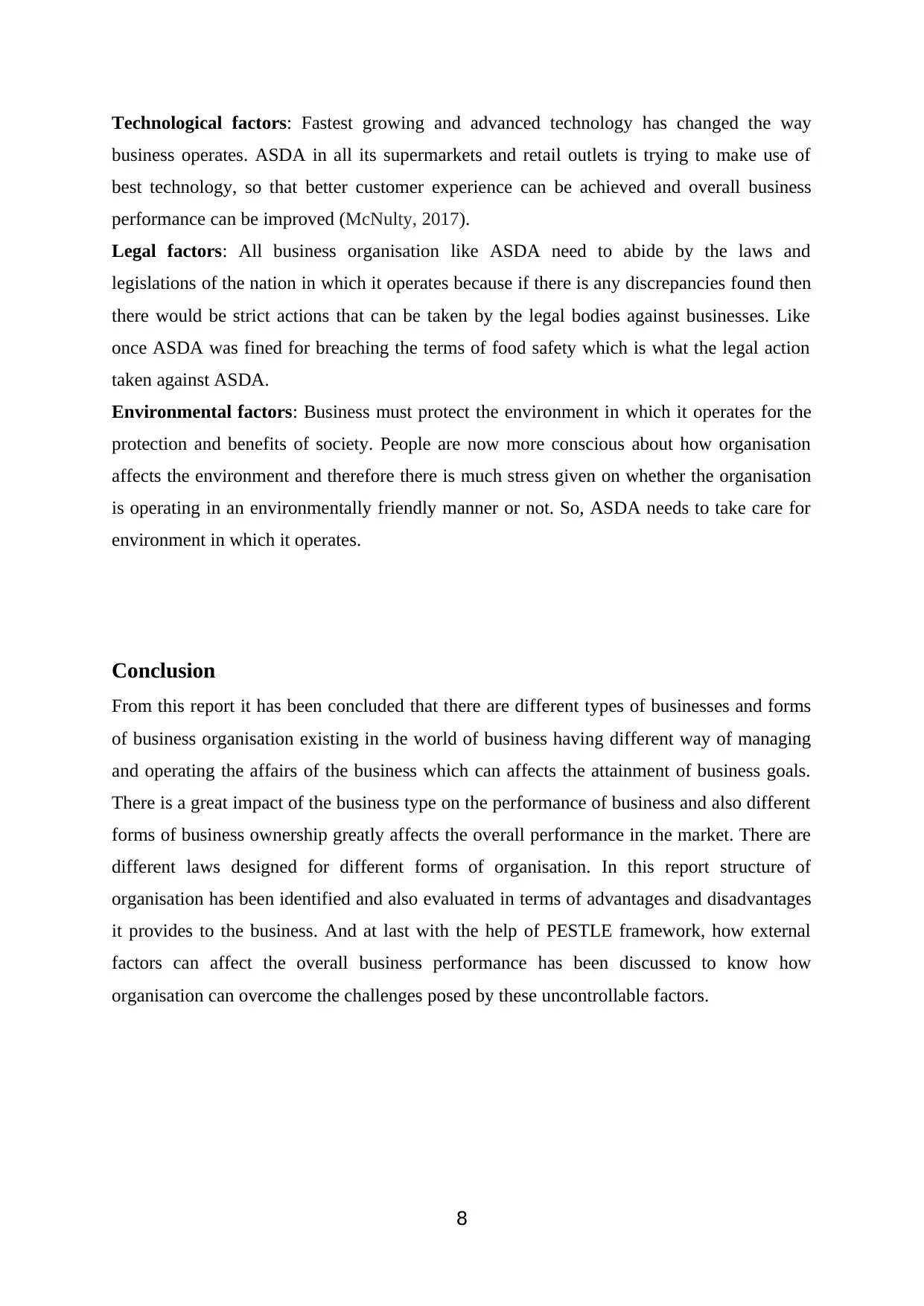
Technological factors: Fastest growing and advanced technology has changed the way
business operates. ASDA in all its supermarkets and retail outlets is trying to make use of
best technology, so that better customer experience can be achieved and overall business
performance can be improved (McNulty, 2017).
Legal factors: All business organisation like ASDA need to abide by the laws and
legislations of the nation in which it operates because if there is any discrepancies found then
there would be strict actions that can be taken by the legal bodies against businesses. Like
once ASDA was fined for breaching the terms of food safety which is what the legal action
taken against ASDA.
Environmental factors: Business must protect the environment in which it operates for the
protection and benefits of society. People are now more conscious about how organisation
affects the environment and therefore there is much stress given on whether the organisation
is operating in an environmentally friendly manner or not. So, ASDA needs to take care for
environment in which it operates.
Conclusion
From this report it has been concluded that there are different types of businesses and forms
of business organisation existing in the world of business having different way of managing
and operating the affairs of the business which can affects the attainment of business goals.
There is a great impact of the business type on the performance of business and also different
forms of business ownership greatly affects the overall performance in the market. There are
different laws designed for different forms of organisation. In this report structure of
organisation has been identified and also evaluated in terms of advantages and disadvantages
it provides to the business. And at last with the help of PESTLE framework, how external
factors can affect the overall business performance has been discussed to know how
organisation can overcome the challenges posed by these uncontrollable factors.
8
business operates. ASDA in all its supermarkets and retail outlets is trying to make use of
best technology, so that better customer experience can be achieved and overall business
performance can be improved (McNulty, 2017).
Legal factors: All business organisation like ASDA need to abide by the laws and
legislations of the nation in which it operates because if there is any discrepancies found then
there would be strict actions that can be taken by the legal bodies against businesses. Like
once ASDA was fined for breaching the terms of food safety which is what the legal action
taken against ASDA.
Environmental factors: Business must protect the environment in which it operates for the
protection and benefits of society. People are now more conscious about how organisation
affects the environment and therefore there is much stress given on whether the organisation
is operating in an environmentally friendly manner or not. So, ASDA needs to take care for
environment in which it operates.
Conclusion
From this report it has been concluded that there are different types of businesses and forms
of business organisation existing in the world of business having different way of managing
and operating the affairs of the business which can affects the attainment of business goals.
There is a great impact of the business type on the performance of business and also different
forms of business ownership greatly affects the overall performance in the market. There are
different laws designed for different forms of organisation. In this report structure of
organisation has been identified and also evaluated in terms of advantages and disadvantages
it provides to the business. And at last with the help of PESTLE framework, how external
factors can affect the overall business performance has been discussed to know how
organisation can overcome the challenges posed by these uncontrollable factors.
8
⊘ This is a preview!⊘
Do you want full access?
Subscribe today to unlock all pages.

Trusted by 1+ million students worldwide
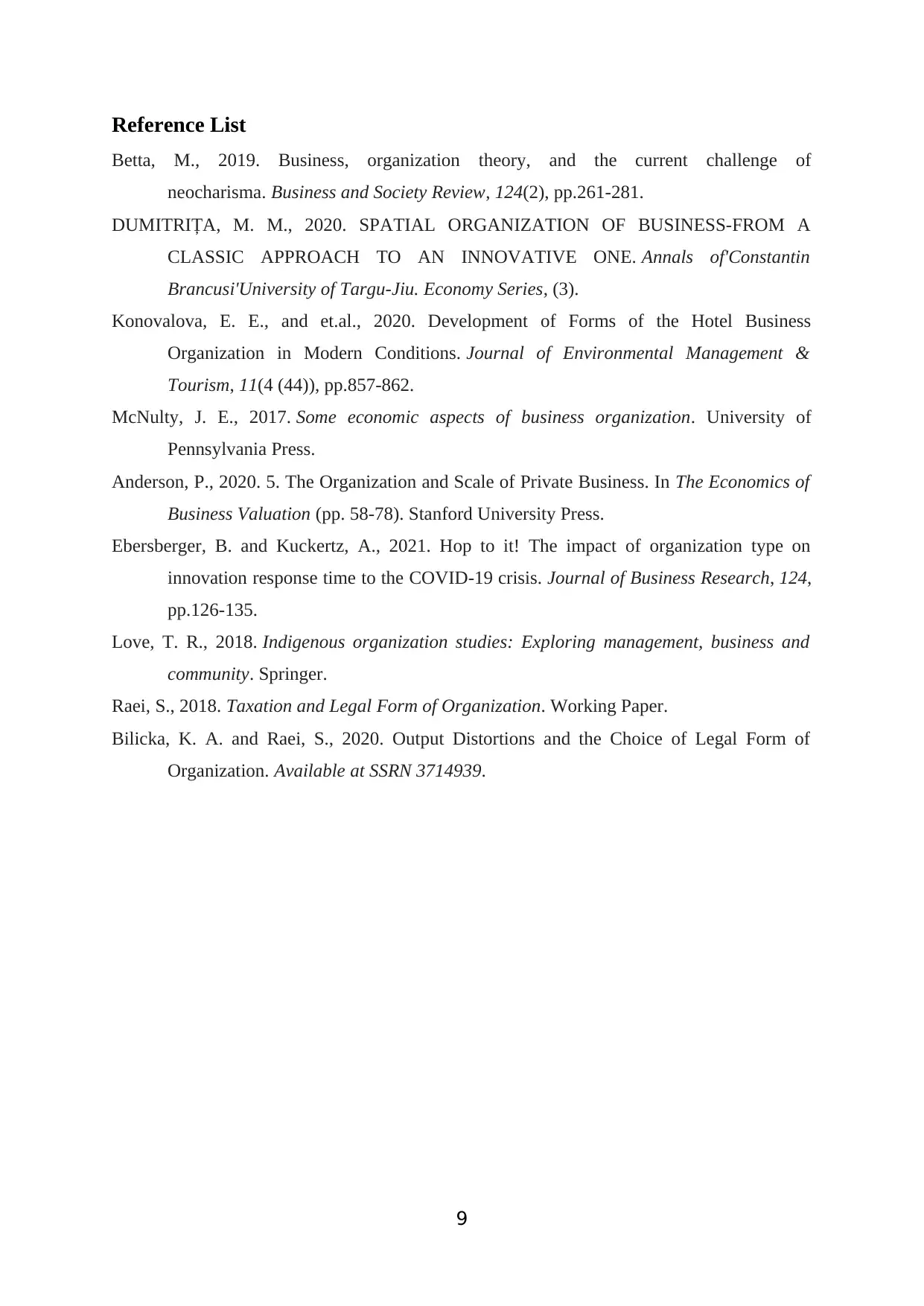
Reference List
Betta, M., 2019. Business, organization theory, and the current challenge of
neocharisma. Business and Society Review, 124(2), pp.261-281.
DUMITRIȚA, M. M., 2020. SPATIAL ORGANIZATION OF BUSINESS-FROM A
CLASSIC APPROACH TO AN INNOVATIVE ONE. Annals of'Constantin
Brancusi'University of Targu-Jiu. Economy Series, (3).
Konovalova, E. E., and et.al., 2020. Development of Forms of the Hotel Business
Organization in Modern Conditions. Journal of Environmental Management &
Tourism, 11(4 (44)), pp.857-862.
McNulty, J. E., 2017. Some economic aspects of business organization. University of
Pennsylvania Press.
Anderson, P., 2020. 5. The Organization and Scale of Private Business. In The Economics of
Business Valuation (pp. 58-78). Stanford University Press.
Ebersberger, B. and Kuckertz, A., 2021. Hop to it! The impact of organization type on
innovation response time to the COVID-19 crisis. Journal of Business Research, 124,
pp.126-135.
Love, T. R., 2018. Indigenous organization studies: Exploring management, business and
community. Springer.
Raei, S., 2018. Taxation and Legal Form of Organization. Working Paper.
Bilicka, K. A. and Raei, S., 2020. Output Distortions and the Choice of Legal Form of
Organization. Available at SSRN 3714939.
9
Betta, M., 2019. Business, organization theory, and the current challenge of
neocharisma. Business and Society Review, 124(2), pp.261-281.
DUMITRIȚA, M. M., 2020. SPATIAL ORGANIZATION OF BUSINESS-FROM A
CLASSIC APPROACH TO AN INNOVATIVE ONE. Annals of'Constantin
Brancusi'University of Targu-Jiu. Economy Series, (3).
Konovalova, E. E., and et.al., 2020. Development of Forms of the Hotel Business
Organization in Modern Conditions. Journal of Environmental Management &
Tourism, 11(4 (44)), pp.857-862.
McNulty, J. E., 2017. Some economic aspects of business organization. University of
Pennsylvania Press.
Anderson, P., 2020. 5. The Organization and Scale of Private Business. In The Economics of
Business Valuation (pp. 58-78). Stanford University Press.
Ebersberger, B. and Kuckertz, A., 2021. Hop to it! The impact of organization type on
innovation response time to the COVID-19 crisis. Journal of Business Research, 124,
pp.126-135.
Love, T. R., 2018. Indigenous organization studies: Exploring management, business and
community. Springer.
Raei, S., 2018. Taxation and Legal Form of Organization. Working Paper.
Bilicka, K. A. and Raei, S., 2020. Output Distortions and the Choice of Legal Form of
Organization. Available at SSRN 3714939.
9
1 out of 10
Related Documents
Your All-in-One AI-Powered Toolkit for Academic Success.
+13062052269
info@desklib.com
Available 24*7 on WhatsApp / Email
![[object Object]](/_next/static/media/star-bottom.7253800d.svg)
Unlock your academic potential
Copyright © 2020–2025 A2Z Services. All Rights Reserved. Developed and managed by ZUCOL.





